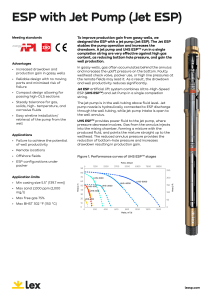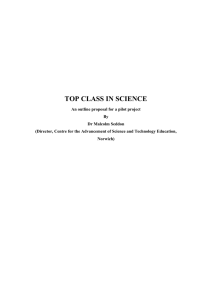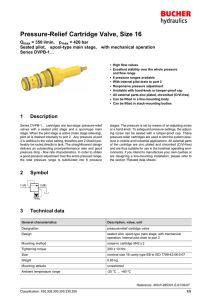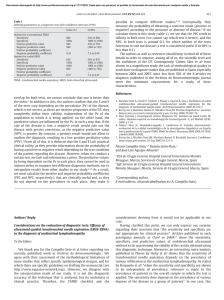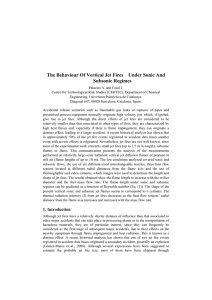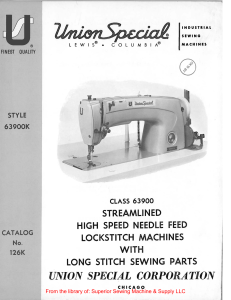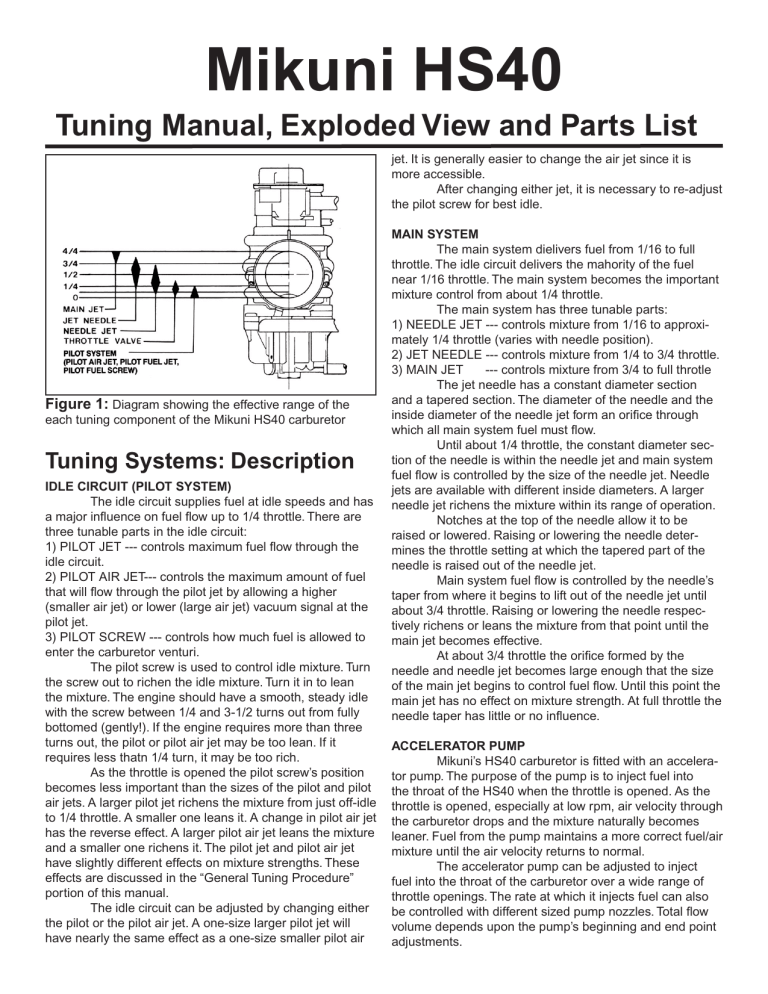
Mikuni HS40 Tuning Manual, Exploded View and Parts List jet. It is generally easier to change the air jet since it is more accessible. After changing either jet, it is necessary to re-adjust the pilot screw for best idle. Figure 1: Diagram showing the effective range of the each tuning component of the Mikuni HS40 carburetor Tuning Systems: Description IDLE CIRCUIT (PILOT SYSTEM) The idle circuit supplies fuel at idle speeds and has a major influence on fuel flow up to 1/4 throttle. There are three tunable parts in the idle circuit: 1) PILOT JET --- controls maximum fuel flow through the idle circuit. 2) PILOT AIR JET--- controls the maximum amount of fuel that will flow through the pilot jet by allowing a higher (smaller air jet) or lower (large air jet) vacuum signal at the pilot jet. 3) PILOT SCREW --- controls how much fuel is allowed to enter the carburetor venturi. The pilot screw is used to control idle mixture. Turn the screw out to richen the idle mixture. Turn it in to lean the mixture. The engine should have a smooth, steady idle with the screw between 1/4 and 3-1/2 turns out from fully bottomed (gently!). If the engine requires more than three turns out, the pilot or pilot air jet may be too lean. If it requires less thatn 1/4 turn, it may be too rich. As the throttle is opened the pilot screw’s position becomes less important than the sizes of the pilot and pilot air jets. A larger pilot jet richens the mixture from just off-idle to 1/4 throttle. A smaller one leans it. A change in pilot air jet has the reverse effect. A larger pilot air jet leans the mixture and a smaller one richens it. The pilot jet and pilot air jet have slightly different effects on mixture strengths. These effects are discussed in the “General Tuning Procedure” portion of this manual. The idle circuit can be adjusted by changing either the pilot or the pilot air jet. A one-size larger pilot jet will have nearly the same effect as a one-size smaller pilot air MAIN SYSTEM The main system dielivers fuel from 1/16 to full throttle. The idle circuit delivers the mahority of the fuel near 1/16 throttle. The main system becomes the important mixture control from about 1/4 throttle. The main system has three tunable parts: 1) NEEDLE JET --- controls mixture from 1/16 to approximately 1/4 throttle (varies with needle position). 2) JET NEEDLE --- controls mixture from 1/4 to 3/4 throttle. 3) MAIN JET --- controls mixture from 3/4 to full throtle The jet needle has a constant diameter section and a tapered section. The diameter of the needle and the inside diameter of the needle jet form an orifice through which all main system fuel must flow. Until about 1/4 throttle, the constant diameter section of the needle is within the needle jet and main system fuel flow is controlled by the size of the needle jet. Needle jets are available with different inside diameters. A larger needle jet richens the mixture within its range of operation. Notches at the top of the needle allow it to be raised or lowered. Raising or lowering the needle determines the throttle setting at which the tapered part of the needle is raised out of the needle jet. Main system fuel flow is controlled by the needle’s taper from where it begins to lift out of the needle jet until about 3/4 throttle. Raising or lowering the needle respectively richens or leans the mixture from that point until the main jet becomes effective. At about 3/4 throttle the orifice formed by the needle and needle jet becomes large enough that the size of the main jet begins to control fuel flow. Until this point the main jet has no effect on mixture strength. At full throttle the needle taper has little or no influence. ACCELERATOR PUMP Mikuni’s HS40 carburetor is fitted with an accelerator pump. The purpose of the pump is to inject fuel into the throat of the HS40 when the throttle is opened. As the throttle is opened, especially at low rpm, air velocity through the carburetor drops and the mixture naturally becomes leaner. Fuel from the pump maintains a more correct fuel/air mixture until the air velocity returns to normal. The accelerator pump can be adjusted to inject fuel into the throat of the carburetor over a wide range of throttle openings. The rate at which it injects fuel can also be controlled with different sized pump nozzles. Total flow volume depends upon the pump’s beginning and end point adjustments. STARTER SYSTEM Mikuni’s starter system takes the place of the crude choke mechanism of the stock carburetor. It is actually a small auxilliary carburetor designed to supply a rather rich mixture for starting purposes. The starter system only works when the choke knob is pulled open and when the throttle is closed. If the throttle is opened with the choke knob pulled out, air essentially ceases to flow through the starter system and it stops delivering its rich mixture to the engine. If the engine begins to load-up while the starter system is engaged, it may be cleared by opening the throttle. When the throttle is closed, the starter system resumes operation. The starter system has one replaceable component, the starter jet. A larger starter jet makes the starter mixture richer and a smaller one makes makes it leaner. The #55 jet fitted to the HS40 will suit most installations. However, if you live in a warm climate, the alternate #45 jet may perform better. DETAILS 1) Throttle return spring adjustment: The throttle return spring has 3 pre-load positions. The HS40 is supplied with the spring in the stronger of the 3 positions. You may wish to try a weaker spring position. However, in some installations, the softer spring position may result in erratic return to idle. 2) Fuel float adjustment: Fuel float level is critical to proper operation of any carburetor, the HS40 is no exception. Mikuni correctly adjusts the floats during assembly but they may be accidentally bent out of adjustment during tuning or other handling. If you have doubts, check the float level and re-adjust if needed. A float level that is too high can make fine tuning of the idle circuit impossible. One that is too low will have a similar effect on mid-range tuning. Figure 2: Diagram showing float level range and checking procedure. Tuning Manual GENERAL TUNING PROCEDURES Your Mikuni is fitted with the tuning parts we found to work with a majority of engine tuning combinations. However, the tremendous number of differing exhaust systems and cams available for Harley engines make it impossible to accommodate all possible combinations with one carburetor set-up. You will probably find that the HS40 will run perfectly on your engine without exchanging any parts. But if it doesn’t, you may alter its tuning to suit your engine’s needs by following this guide. There are many more replaceable parts that affect tuning in the HS40 than in the stock Harley carburetor. With these parts you can precisely tailor the HS40’s tuning to your engine’s requirements throughout its rpm and throttle setting range. Each tuning system is easy to modify and diagnose, but only when you understand what each system does and how it works. Before making any alterations to the HS40, if any are needed at all, read the section of this manual describing the various components and their functional range. There is simply no point in attempting to tune any carburetor unless the engine is completely sound. Valves and rings must seal properly, the ignition timing must be correct and the spark plugs clean and gapped. Some exhaust systems may also make carburetor tuning difficult. For instance, it is almost impossible to get smooth responsive carburetion with straight and open pipes. If you have and doubts about the condition of your engine, tune and test it before beginning what could be a frustrating and unproductive effort to fix another problem with the carburetor. TUNING THE IDLE CIRCUIT (PILOT SYSTEM) The first step in tuning any carburetor is to get the idle circuit correctly adjusted. And, the first step in this procedure is to adjust the pilot screw position for best idle. Mikuni sets the pilot screw at three turns open during assembly. This is the position we have found to be right most of the time. If the screw position has been altered, gently bottom it and re-open to three turns out. Next, ride the bike until the engine is at its normal operating temperature. This may require several miles at highway speeds. If you have an oil temperature gauge, ride until the oil temperature is at or near 150 degrees. With the machine vertical and the engine idling near 1,000 rpm, adjust the pilot screw in one-half turn at a time until the idle either slows or becomes irregular. The pilot screw is now in too far and the idle mixture is too lean. Pause for a few seconds at each half turn to allow the engine to settle down and give a clear indication of the mixture strength. Now, begin turning the screw out in half turn intervals until the engine again slows or begins an irregular idle. Count the turns between the too-lean and too-rich positions. Set the pilot screw mid-way between the too-lean and too-rich positions. You may further refine the pilot screw position with riding experience but this setting will be very close to the correct idle mixture setting. If you allow the engine to get too hot during the pilot screw adjustment procedure, the resulting adjustment will probably be on the lean side of correct. If you have a large fan use it while adjusting the idle mixture. If you do not have one, you may need to take time out for a short ride to cool the engine back to the normal temperature range. Remember, if best idle is achieved with the pilot screw less that 1/4 turn out, the pilot jet is too large or the pilot air jet is too small. One or the other will need to be changed. On the other hand, if the pilot jet screw must be more than three and a half turns out for best idle, the pilot jet is too small (or the pilot air jet is too large). One or the other will need to be changed. If the pilot screw’s best idle position is outside the 1/4 to 3-1/2 turn range, the carburetor’s mixture will be either too lean or too rich as the throttle is just being raised off the idle position. Once you have a good idle with the screw within this range, you may proceed to the next stage: tuning the needle jet. The pilot air jet is selected while riding at 15 to 30 mph. If the engine surges or detonates (lean), the pilot air jet should be reduced in size. Example: 1.1 to 1.0. If, on the other hand, the engine misfires or there is after burn (popping) from the exhaust (rich), it would indicate that pilot air jet is too small. If the air jet is changed, the pilot screw should be re-checked and adjusted if needed. As mentioned earlier, the idle circuit has an important effect on mixtures up to quarter throttle. However, the idle system’s effect on mixture strength overlaps the effect of the neelde jet in this range. If the idle circuit is incorrectly adjusted, it will not be possible to get the needle jet correct. TUNING THE NEEDLE JET It is unlikely that you will need to change the needle jet from the one supplied in your Mikuni HS40. However, in case you do, you should be aware of how it works and how to tell if the one you have it too large (rich) or too small for your particular engine set up. The needle jet’s effect on mixture is limited from about 1/16 throttle, where the main system begins to deliver fuel, to 1/4 throtlle, when the tapered section of the needle begins to emerge from the mouth of the needle jet. LEAN CONDITION If the needle jet is too small (lean), part throttle acceleration will be flat. There may also be some detonation during part throttle acceleration although this can be caused by other factors. A lean needle jet will also result in a slow warm up. If part throttle acceleration is flat, install a one-size larger needle jet and compare the performance. If acceleration is improved, leave the larger jet in and take a fairly long ride at steady speeds to give the spark plugs time to color evenly. Take a spark plug wrench with you and after a few miles at steady speeds, stop and remove a plug for inspection. Be careful as you stop not to operate the throttle. The extra fuel from the accelerator pump can cause a false plug reading. The body of a spark plug can be from light grey to brown to dark grey. If the plug body is black and has a sooty appearance then the needle jet is probably too rich and a smaller one will need to be fitted. RICH CONDITION While a black and sooty spark plug is a sure sign of richness, there are others that are a bit more subtle. If your engine responds crisply at low throttle when it is cold, chances are the needle jet is one size larger than it needs to be. Assuming, of course, that the idle circuit is correctly tuned and adjusted. Poor fuel mileage is another sign of richness and because of the way most of us ride our Harleys, that richness is usually the result of a needle jet that is too large. The color of the end of the exhausts is a sign of mixture strength. Dark grey with some black is normal for today’s lead free gasolines. If the exhaust color is black, chances are you can reduce the size of the needle jet. It may be that you might prefer a needle jet that is slightly on the rich side of the correct range. A slightly over-rich condition lets a Harley accelerate a little better at very low (1,000 - 1,500) rpm and with very low throttle settings. Be aware that you will lose some fuel economy if you choose to do this. TUNING THE JET NEEDLE Like the idle circuit and needle jet, the needle, within its range of operation, has a gradually increasing effect on fuel mixture as the throttle is opened. From the time (about 1/4 throttle) that the tapered section of the needle leaves the mouth of the needle jet, it has a major effect on the on the amount of fuel entering the engine. Between 1/2 and 3/4 throttle the needle’s influence is greatest and it contols most of the fuel flow. All needle and main jet testing should be done wiht the engine near the middle of its rpm range. Start your acceleration tests at about 50 mph. The best needle position will give the strongest acceleration. With the engine at operating temperature, accelerate at 1/2 to 3/4 throttle, in top gear, from 50 mph or so. If acceleration seems soft or flat and the engine is slow to respond when the throttle is quickly opened from the 1/2 to the 3/4 throttle position, the mixture is too lean. Raise the needle one notch and repeat the test. One the other hand, if acceleration is crisp but the engine hesitates or staggers when the throttle is suddenly shut down from 3/4 to 1/2 throttle, the mixture is too rich. Lower the needle one notch and repeat the test. The needle position will be correct when acceleration is crisp at mid rpm yet the engine does not load up during throttle shut down. TUNING THE MAIN JET You could, in fact, remove the main jet from your Mikuni HS40 and the engine would run fine until the throttle was near the 3/4 mark. The needle and needle jet restrict the amount of fuel getting into the engine until about that position. There is no point in changing main jets if a mixture problem exists below the 3/4 throttle position. The main jet is the last jet you need to deal with and is the easiest to get right, if you have the room. The most effective method for getting the main jet right is to measure the time required to accelerate between two points. The start and end marker should be spaced so that starting at about 35 mph at the first marker will have you going past the second at near 55+ mph. Select markers (telephone poles do nicely) that are far enough apart, on a safe road, to meet the conditions given above. As you pass the first marker, roll the throttle fully open. Note the rpm or speed at the second marker. The jet that gives the highest rpm or speed at the second marker is the correct one. This method is simple and completely accurate. ACCELERATOR PUMP TUNING The beginning point of the stroke is adjusted with adjusting screw #1 on the white plastic pump lever. To start the pump sooner, back the screw out. Turn the screw in to make the pump start its stroke at a larger throttle opening. Most engines perform best if the pump begins its stroke as soon as the throttle is moved from the idle position. The end point of the accelerator pump stroke is adjusted by the adjusting screw #2 located on the top of the carburetor just behind the pump lever. Best performance is generally achieved when the pump stroke ends at about 3/4 throttle. It is important that the nozzle’s direction be correctly set. The nozzle is held in position by the friction of its O-ring seal and can be turned quite easily with a pair of long nosed pliers. Rotate the nozzle until the fuel stream strikes the needle. This ensures an even distribution of fuel between the front and rear cylinders. Nozzle adjustment should be made with the engine stopped and with a minimum of pump strokes to avoid flooding. FINE TUNING THE PILOT SYSTEM NOTE: Before you apply any of the information in this section be sure that the basic pilot system is correct. Be sure that your engine idles smoothly with the mixture screw between one and three turns out from its seated position. The pilot and pilot air jets have slightly different effects on mixture strength within the effective tuning range of the pilot system (0/0 to 1/4 throttle). When you change the pilot jet, it has a slightly greater effect on mixture strength at zero throttle than it does at 1/4 throttle. On the other hand, when you change the pilot air jet, it has a slightly greater effect above 1/8 throttle that is does below that setting. If your engine has slightly soft acceleration just as the throttle is raised from the idle position, the size balance between the pilot jet and and pilot air jet may be incorrect. If the softness is more pronounced whe the engine is at normal running temperature, install a larger (leaner) pilot air jet. If there is minor coughing or “popping” through the carburetor when the engine is cool, install a smaller (richer) pilot air jet. After you have changed the pilot air jet, you will need to re-adjust the mixture screw. If the new mixture screw adjustment is outside the one to three turn range, change the pilot jet. If the mixture screw must be more than three turns out to get a correct idle, install the next larger (richer) pilot jet. However, if less than one turn is required to get a good idle fit the next smaller pilot jet. It is unlikely that changing the pilot jet will require changing the pilot air jet. Figure 3: Accelerator pump stroke adjustor components
